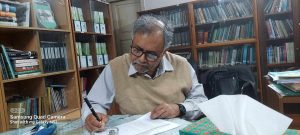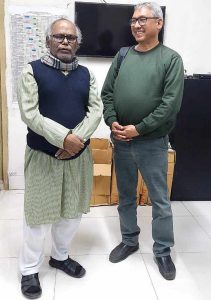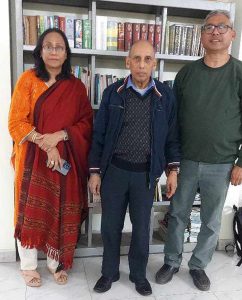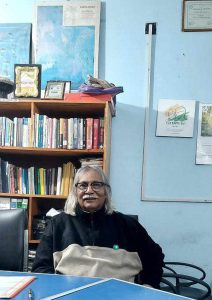After returning from Dhaka: I had been planning to visit Bangladesh for a long time, as it was important for me to complete my work on the River Ganga. It has been an amazing journey—from the Himalayas to the Bay of Bengal—that provided insights into how the river is formed and how it empties into the sea. The Ganga is a shining example of how to handle differences and diversity. It originates in diversity, with all its tributaries eventually embracing its identity and becoming one. Yet, at the end of its journey, it adopts a different identity, splitting into multiple channels before merging into the Bay of Bengal. The river demonstrates the importance of interdependence, assimilation, and inclusion. After completing my journey to the Sundarbans on the Indian side, it was always a dream to witness the Ganges’ remarkable journey in Bangladesh, as without it, the journey would remain incomplete. However, my visit coincided with a political crisis in Bangladesh, triggered by student protests in Dhaka and the subsequent removal of Sheikh Hasina Wazed, who fled to India.
Political Crisis in Bangladesh: The Key Players
There is no doubt that Bangladesh was in the midst of a political crisis, with various forces vying for influence. The country primarily has two major political parties: the Awami League and the Bangladesh Nationalist Party (BNP). The main conflict has been between these two forces. A third group, Jamaat-e-Islami, also exists but lacks substantial influence. Like other opposition groups, Jamaat was a victim of Hasina’s authoritarianism, which led to its increased activity after her removal.
The decision to travel to Bangladesh was not easy. At the airport, a CISF security personnel asked, “Sir, aren’t you afraid of going there?” At immigration, the officer on duty questioned, “Why are you going there?” I had read that rupee-to-taka conversion was possible, but I was disappointed to find no such facility at the airport. However, upon landing in Dhaka, I found numerous currency exchangers willing to accept rupees. Why should I need US dollars to visit a South Asian neighbor? I wanted to challenge the dollar’s monopoly. It is ironic that we can travel to continents like Africa and Latin America but face barriers in visiting our own neighborhood.

The Role of Indian Media in Fueling Tensions
I am well aware of Bangladesh’s liberation movement and have visited the country before. The people have always been cooperative and appreciative of India’s role in their liberation. However, this time, following Hasina’s exit, the situation was more challenging. What exacerbated the crisis was the role played by the Indian media. Instead of allowing diplomacy to address the situation, the media behaved as if it were campaigning for local elections in India, with some BJP leaders even coining the term “Bangladeshi ghushpethia” (illegal immigrants). The people of Bangladesh are well aware of this. Even as India’s visa regime has become stricter, labeling the entire population as anti-India is detrimental to India’s interests.
Fear and Mistrust on the Ground
When I began my journey, I was uncertain about how things would unfold. It was difficult to openly use my camera or speak to people, as I sensed a lot of anger toward the Indian media’s portrayal of the crisis. People were protesting against Sheikh Hasina’s authoritarianism—a fundamental right in any democracy—but the media spun its own narrative. While organizations like Jamaat-e-Islami have become more active since the August incident, it would be challenging for them to gain significant traction. Asif Chowdhury, a research scholar, noted, “Sheikh Hasina still has strong support within the country, and it would be difficult to politically eliminate the Awami League.”

Mohammad Kamaluddin, a senior activist based in Dhaka who was a student during the 1971 Liberation War, believes that corruption is not the core issue, as the entire system is corrupt. Those now in power are also part of the same system. While Sheikh Hasina may have been authoritarian, the right way to address this would have been through political means and elections. Kamaluddin sees the rise of Bangladesh as a defeat for both the United States and the idea of nationality based on Islam. Bangla nationalism, he argues, countered American hegemony in South Asia and the political Islam espoused by Pakistan. Kamaluddin is a strong advocate for the rights of minorities and marginalized groups, not just in Bangladesh but across South Asia. He emphasizes the importance of good relations among South Asian countries to foster cultural exchange and mutual learning.
Mistrust of Indian Media and the Future of Bangladesh
Activist Zakir Hossain expressed frustration with the Indian media’s approach. “Why do they bring conspiracy theories into everything?” he asked. People were upset with Sheikh Hasina’s authoritarianism, and the revolution was a result of their frustration reaching a breaking point. He was particularly upset by Indian media reports claiming that Hindus were living in fear and that the constitution was being changed to establish an Islamic state. So far, none of this has happened. Various committees are being formed to seek opinions from civil society activists, academics, intellectuals, and political leaders. Zakir recounted an interview with an Indian “alternative media” journalist, where the questions were framed to elicit responses that fit their narrative. “It’s sad,” he said.
Shamsul Huda, a senior civil society leader in Bangladesh, highlighted the rampant corruption during Hasina’s tenure. He praised the students for rising in defense of people’s rights but condemned any violence against minorities. He clarified that most of the targeted individuals were Awami League leaders. Huda expressed optimism about the ongoing discussions for a new constitution and systemic changes, noting that the economy is improving and normalcy is returning. However, he was critical of Indian media coverage, which he felt was biased and sensationalized. He mentioned that there are talks of limiting the prime minister to two terms and introducing other constitutional reforms to reflect Bangladesh’s diversity.

Rowshan Jahan Moni, another civil society activist in Dhaka, criticized Indian news channels for their sensationalism. She emphasized that Bangladesh’s strong people’s movement led to systemic change, not just a change in government. She expressed hope that the ongoing constitutional reforms would create checks and balances to prevent future authoritarianism. Moni also noted that life has returned to normal, with people going about their daily routines.
The People’s Perspective
My friend Shah Mobin Jinnah, a veteran activist in Dinajpur, described the movement as a people’s uprising against authoritarianism. While he acknowledged Sheikh Hasina’s contributions to infrastructure and economic growth, he also recognized the issues that led to her downfall. Jinnah is a strong advocate for South Asian solidarity and people-to-people contact. He criticized the media for being a tool of the powerful and failing to report ground realities.
A young Uber bike rider in Dhaka spoke to me in Hindi, saying, “Sir, main Hindi me baat kar leta hoon (I can speak Hindi).” When I asked how he learned it, he replied, “I’m a big fan of Shah Rukh Khan.” He expressed a desire to visit India, calling it a great friend. He believed that in five years, people would realize Sheikh Hasina’s contributions but acknowledged that it was now the students’ responsibility to deliver. He enjoyed Indian entertainment but avoided Indian news channels, which he felt were more concerned about Sheikh Hasina than the people of Bangladesh.

A People’s Movement, Not a Religious Conflict
Most of the people I spoke with support greater people-to-people contact across South Asia. They believe that democracy was under threat, and students united to resist an increasingly dictatorial regime. Even if mistakes were made, the people of Bangladesh should decide their own future.
While concerns about Jamaat-e-Islami exist, activists believe that Bangladesh’s inclusive culture will not allow religious extremism to take hold. The claim that Bangladesh is becoming an Islamic jihadist state is a baseless attempt to discredit a genuine pro-democracy movement. The graffiti on Dhaka’s walls and in smaller towns reflects a vision of an inclusive society, proving that the people’s aspirations go beyond religious divides.
As I left Bangladesh, I was reminded that while political elites and media narratives often create divisions, ordinary people continue to believe in coexistence, democracy, and regional solidarity.
Watch Vidya Bhushan Rawat’s Ganga journey in Bangladesh


